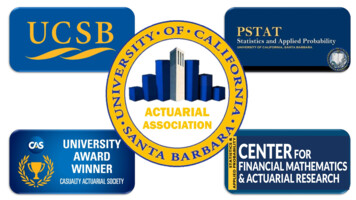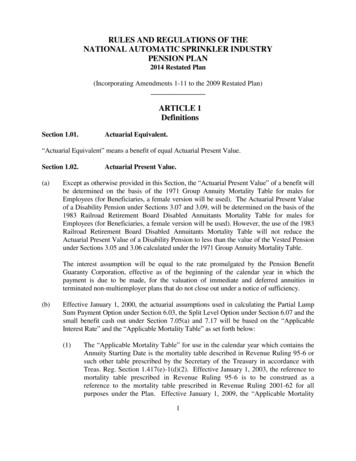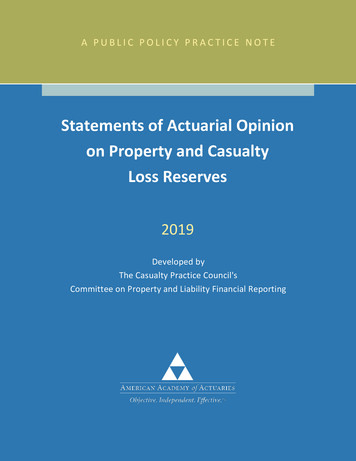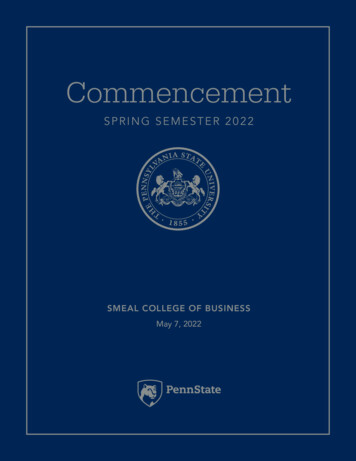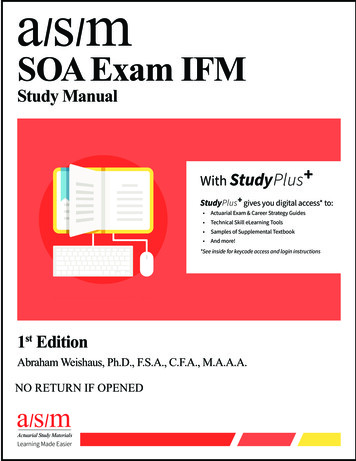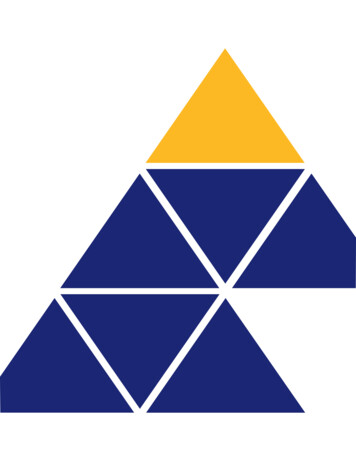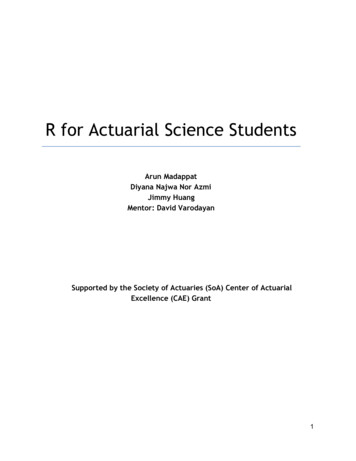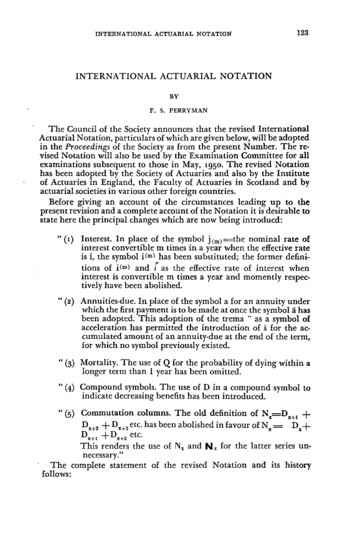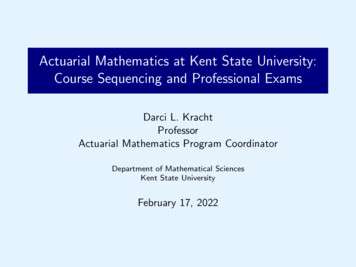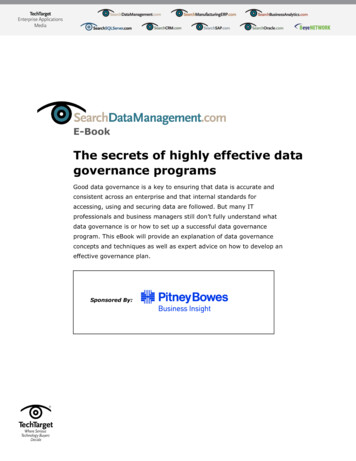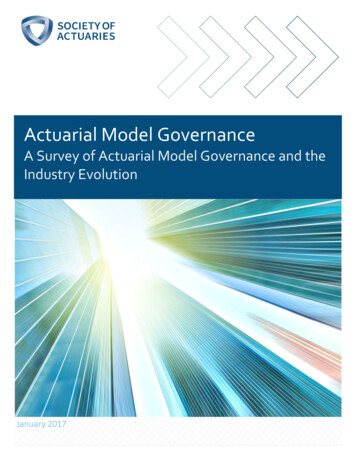
Transcription
Actuarial Model GovernanceA Survey of Actuarial Model Governance and theIndustry EvolutionJanuary 2017
2Actuarial Model GovernanceA Survey of Acturial Model Governance and theIndustry EvolutionSPONSORModeling SectionFinancial Reporting SectionAUTHORSThomas Chamberlain, ASA, MAAACharles Deak, ASA, MAAA, CERAKatie Egan, FSA, CERASara Viet Kaufman, FSA, MAAAJason Morton, FSA, MAAACaveat and DisclaimerThe opinions expressed and conclusions reached by the authors are their own and do not represent any official position or opinion of the Society of Actuaries or itsmembers. The Society of Actuaries makes no representation or warranty to the accuracy of the information.Copyright 2017 All rights reserved by the Society of Actuaries 2017 Society of Actuaries
3Table of ContentsSection 1: Disclaimer of Liability . 4Section 2: Executive Summary . 5Section 3: Survey Method. 7Online Survey . 7Follow-up Discussion . 7Section 4: Demographic Information of Respondents . 8Data. 8Section 5: Survey Results and Analysis .10Section 6: Governance Standards .11Current State and Recent Developments . 11Leading Practices . 12Industry Assessment and Next Steps . 13Section 7: Modeling Process .13Current State and Recent Developments . 14Leading Practices . 15Industry Assessment and Next Steps . 15Section 8: System Access and Change Control .17Current State and Recent Developments . 17Leading Practices . 18Industry Assessment and Next Steps . 18Section 9: Model Assumption Management .19Current State and Recent Developments . 19Leading Practices . 20Industry Assessment and Next Steps . 21Section 10: Model Input and Output Management .21Current State and Recent Developments . 21Leading Practices . 24Industry Assessment and Next Steps . 24Section 11: Organizational Design .25Current State Assessment . 25Leading Practices . 26Industry Readiness Assessment . 27Appendix A: Acknowledgments .28Appendix B: Actuarial Modeling Controls Survey .29Appendix C: Survey Participants .44
4Section 1: Disclaimer of LiabilityIn completing this report, Deloitte Consulting LLP (“Deloitte Consulting”) has relied upon the information and data supplied bythe survey participants. We performed no reviews or independent verification of the information furnished to us, although wehave reviewed the data for general reasonableness and consistency. To the extent that there are material errors in theinformation provided, the results of our analysis contained in this report will be affected as well. Any distribution of this reportmust be in its entirety. Nothing contained in this report is to be used in any filings with any public body, including, but not limitedto state regulators, the Internal Revenue Service and the U.S. Securities and Exchange Commission. Deloitte Consulting, itsdirectors, officers and employees disclaim liability for any loss or damage arising or resulting from any error or omission inDeloitte Consulting’s analysis and summary of the survey results or any other information contained herein. The report is to bereviewed and understood as a complete document. The information included in this report is for informational purposes onlyand should not be construed as professional or financial advice.This report is published by the Society of Actuaries and contains information based on input from companies engaged in theinsurance industry. Neither the SOA, Deloitte Consulting nor the participating companies recommend, encourage or endorse anyparticular use of the information provided in this report. The SOA and Deloitte Consulting make no warranty, guarantee orrepresentation whatsoever and assume no liability or responsibility in connection with the use or misuse of this report.
5Section 2: Executive SummaryThe life insurance and annuity industry is moving toward increased demand for projection-based models used for reporting andmanagement decision making. In this new environment, the high reliance that companies and regulatory agencies place onmodeled results will require a well-developed, monitored and maintained control framework to ensure the quality of all modelsand supporting processes.A team from Deloitte Consulting LLP, led by Jason Morton and Thomas Chamberlain, performed the research and analysiscontained within this report. The team received administrative support from the Society of Actuaries (SOA) and direction fromthe Project Oversight Group (POG). Through a combination of an online survey and follow-up discussions with surveyrespondents, the current state of actuarial modeling controls within U.S. and Canadian life insurance and annuity companies wasestablished. The current state was then compared to prior research conducted in 2012 in the report “Actuarial ModelingControls: A Survey of Actuarial Modeling Controls in the Context of a Model-Based Valuation Framework” to highlight theevolution in actuarial model controls and governance over the past four years. After reflecting on the current state and recentdevelopments, the report provides an industry assessment and proposes considerations for enhancing the current state toward awell-controlled governance framework.2.1 Overall ResultsIn conducting this research project we found a wide variety of actuarial model governance components and controls currently inplace in the industry. As a summary, we compared the findings to the industry “scorecard” from the 2012 survey. The scale isfrom 1 to 5, where a 1 indicates that current industry practices are generally aligned with industry leading practices (highestrating), and a 5 indicates that current industry practices differ significantly from industry leading practices (lowest 016 Current State SynopsisGovernanceStandards32General ModelingProcess32.5System Access andChange ControlModel AssumptionManagementModel InputManagementModel OutputManagement42.5322222n/a4Many companies have developed and implemented a formal, holistic modelgovernance framework covering several of the components addressed in thisreport.Companies are consolidating systems, but there are opportunities to redesignprocesses and utilize technology to govern and control actuarial modelingprocesses.Many companies have implemented formal change control processes, butprojection models are still less controlled than valuation models.Formal assumption management governance and processes are in place, butassumption storage and input are still highly manual.Many companies use automated feeds from administrative systems formodel inputs of liabilities. Other model inputs are often less automated.Model output used for financial reporting purposes is generally wellcontrolled, while model output for analysis and other purposes is generallyless controlled.Companies are developing the appropriate roles, responsibilities, processesand technology to maintain effective actuarial model governance while alsobecoming more efficientOrganizationalDesign2.2 Model Governance—Effective and EfficientFigure 1 depicts the progression of actuarial modeling controls within the industry. When the first survey was administered in2012, the report indicated that most companies were in the initial stages of developing model governance standards. The focuswas on “what” to implement to meet the enhanced model governance demands.Based on this most recent research, we have observed actuarial model governance has matured across the industry. Companieshave done significant work during the last four years and are establishing more robust actuarial model governance and controlframeworks. With all this effort, the focus within the industry has started to shift toward “how”—how to implement actuarial
6model governance in a way that is robust and effective, but also efficient and sustainable. Actuarial model governance isessential, but for the industry to reach a mature state, actuarial model governance will need to become more efficient andembedded within companies’ processes, technology and culture.In reviewing the results for the 2016 study, two common themes emerged—themes that are consistent with the maturity ofactuarial model governance within the industry, where companies have implemented actuarial model governance and are nowlooking to optimize what is done: Efficiency. The demands of a robust, formalized governance framework have constrained organizations’ time andresources. Almost all companies, both small and large, expressed the need for more resources to accomplish governancegoals. Organizations are being asked to do more without significant additional resources, so companies are looking forways to increase efficiency, such as enhanced automation or partnership with IT.Consistency. Organizations are striving toward consistency in assumption, methodology and documentationrequirements. The creation of committees and risk groups will help facilitate consistency across organizations.In addition to the common themes, additional observations can be made based on the analysis of the survey results and interviews: Governance frameworks have become more formalized over the past four years to ensure the modeling process is wellcontrolled and repeatable. Management has been a key driver at organizations recognizing the increased need forgovernance to ensure models used for making financial decisions can be trusted and relied on.The organizational design of companies has changed to accommodate the increased demands of governancerequirements. Many organizations have hired new personnel or created new roles to address their needs.The governance and controls surrounding valuation reporting tend to be more robust than projection-based models.As the industry is moving toward projection models, companies should standardize actuarial model governance acrossall actuarial functions regardless of model purpose.Model assumption management has seen a greater focus as compared to model input or output management. Manyorganizations have created assumption management committees to formalize the assumption management process.Information technology (IT) involvement in the modeling process is still minimal in the industry, but increasedinvolvement could improve automation and controls. Processes should be enhanced to remove the manual aspect ofcreating data files and referencing data files in the model, where feasible.
7In each section of the report, we have identified the industry assessment and the next steps to move toward leading practices inwhich actuarial model governance is both effective and efficient. The leading practices represent those implemented by someorganizations but not yet widely adopted throughout the industry. These steps are summarized here and elaborated on in moredetail throughout the report: Use a risk-based approach for actuarial model governance that prioritizes and aligns governance requirements with thelargest risksRedesign modeling processes to embed actuarial model governance and controls and eliminate manual processesPartner with IT to leverage IT solutions and skill sets for modeling process automation, controlled modelingenvironments, model development and model testingConsolidate actuarial modeling systems and platforms where appropriateCentralize components of the modeling process (inforce files, assumptions, production runs, etc.) where significantsimilarities existRequire reported results to come from a model that is governed by robust change control processesCentralize storage of assumptions, model input and outputAlign skills with roles and responsibilities and regularly review as model governance standards matureSection 3: Survey MethodThis research project was performed via use of a survey, carried out by Jason Morton, Thomas Chamberlain, Charles Deak, KatieEgan and Sara Veit Kaufman of Deloitte Consulting LLP (the research team) in conjunction with Ronora Stryker and Jan Schuh ofthe Society of Actuaries (SOA) and members of the Project Oversight Group (POG).The research team gathered information from participants in two ways: an online survey for all respondents, plus a subsequentfollow-up discussion with those respondents that volunteered to participate in a live meeting.3.1 Online SurveyThe 2016 online survey consisted of 52 core questions, spanning seven key aspects of the actuarial modeling process. Dependingupon the way in which core questions were answered, additional questions were asked. Similar to the 2012 online survey, the2016 online survey was developed by the research team and circulated for review by the POG. The online survey wasadministered using the Qualtrics system. Online survey results were collected during March through May 2016. The survey wasdelivered electronically to actuaries representing 150 life and annuity companies in the United States and Canada. Thedistribution list was compiled from the SOA’s member database, identifying primarily Chief Actuaries and Appointed Actuaries.The survey was also distributed to the SOA Modeling Section. Although the research team distributed the survey to specifiedactuarial contacts within each company, we allowed and encouraged those who were selected to solicit participation from, orentirely delegate to, another representative within their organization who was better equipped to respond. In doing this, wereceived information from various areas within an organization that use actuarial models: financial reporting, valuation, pricingand modeling. We received responses from 56 unique companies to the online survey.3.2 Follow-up DiscussionAt the beginning of the online survey, participants were asked to participate in a follow-up conversation. The objectives of theconversation were the following:1.2.3.To clarify respondent interpretations of online survey questionsTo better understand the rationale for the manner in which certain responses were determinedTo more precisely itemize the controls in practiceOf the 56 responses to the online survey, more than half of the companies (29) volunteered to participate in a follow-updiscussion. We conducted the follow-up discussions according to a discussion agenda which was developed to ensure theconsistency of the covered topics. Each discussion was facilitated by a moderator along with support from other survey teammembers. Notes of the discussion were taken and summarized by team members to go back to the company with any additionalquestions and to include specific examples in this report.
8Section 4: Demographic Information of RespondentsThe respondents of the online survey represent a diverse group of companies across size, reporting structure and type ofcompany. The level of diversity affords the opportunity to better dissect the information, stratify responses by size (for example)and make the survey results and conclusions more directly applicable to the reader.The breadth of companies that responded to the survey provides many perspectives on the current state of controls: size,product lines and accounting regimes. Leading practices, and the movement toward leading practices, will have differentimplications for each company within the industry. It is expected that actuaries reading this report will have their own “viewinglens” that is based upon their company’s size, culture, constraints and the level of sophistication required, but will benefit fromthis report by identifying with certain groups of the respondent pool and benchmarking against those groups. Having this diversepool of respondents allows for the analysis of consistency of practice as well as identification of items that are more applicable toa particular sub-segment of the industry.4.1 Data4.1.1 IndustryConsistent with the 2012 survey, the majority of companies participating in this survey are life insurance and annuity companies,while the remaining respondents are multiline insurance companies (Figure 2). Therefore, this report is not considered to fullycapture the current state of actuarial modeling controls for property and casualty or health insurance companies. However, it isexpected that the current state of controls would be comparable, and property and casualty or health insurance companies canderive value from the research and identify with certain respondents with respect to robustness of controls and governance.4.1.2 Geographic DistributionApproximately 80% of the respondents are U.S.–owned companies with most of their operations in the United States. SeveralU.S.-based and Canadian-based companies noted operations in various other countries. In addition to the U.S. respondents, wealso received responses from Canadian-owned, Japanese-owned and U.S.-based subsidiaries of companies with European orJapanese parents (Figure 3). The diversity in geography is valuable, because different locations have been under differentregulatory and reporting environments that require various levels of modeling and, therefore, model controls.
94.1.3 Company SizeThe companies that participated in the survey represent a cross section of different sizes. The 2016 survey had a majority ofresponses from companies characterized as large (greater than 25 billion of assets), whereas the majority of the respondents in2012 were characterized as midsize (between 1 billion and 25 billion of assets) (Figure 4). Approximately three-fifths of thecompanies responding to the 2016 survey have assets over 25 billion, one-third have assets from 1 billion to 25 billion, andonly one-tenth have assets less than 1 billion. Such diversity allows us to group companies and identify discernible patterns ofcontrols and governance according to size.
104.1.4 Company TypeThe mix of respondents between public, private and mutual/fraternal companies is evenly split during the 2012 and 2016surveys. Of the responses, 26% are public companies, 44% are mutual/fraternal companies, and 30% are privately held stockcompanies (Figure 5). Thus, the companies contained within the survey have been subject to Sarbanes-Oxley (public) as well asModel Audit Rule controls.Section 5: Survey Results and AnalysisThe body of the report is structured according to key components of the actuarial modeling process and is consistent with thestructure of the online survey. Each section discusses survey results, changes since the 2012 survey, leading practices and overallmaturity of the industry with respect to actuarial modeling governance and controls. The sections are the following: Governance StandardsGeneral Modeling ProcessSystems Access and Change ControlModel Assumption ManagementModel Input and Output ManagementOrganizational DesignWithin each section, we provide an analysis of the current state of actuarial model governance and controls, combining datacollected from the online results and follow-up discussions. Where meaningful to do so, we stratify results to allow for a greaterdepth of understanding.Note: Because of the designed anonymity of the online survey, we cannot comment on the number of respondents whoparticipated in both 2012 and 2016 with certainty. However, to baseline the responses, in our follow-up interviews we discussedimprovements in model governance over the last several years with all participants.
11Section 6: Governance StandardsModel governance standards are playing an increasingly important role in the life insurance industry as regulators and companymanagement continue to recognize the potential risks of actuarial models. Model governance standards have allowed companiesto create a formal framework and holistic application of actuarial model governance throughout the modeling process, includingdevelopment of data and assumptions, management of calculation engines and review of output and results. Formal modelgovernance standards also support consistency throughout the organization and communication of risks and risk managementstrategies.Over half of the respondents to the survey indicated that model governance standards have helped their organization to identifyand correct a model error prior to reporting results; this indicates that model governance standards are providing material valueto companies.6.1 Current State and Recent DevelopmentsThe prevalence of model governance standards has improved since 2012. In the most recent survey, 75% of participantsindicated they have formal, written governance standards in place, up from 50% in the previous report (Figure 6). In follow-updiscussions, companies indicated that they were at various steps in the process of implementing formal standards, which drovethe strong interest and participation in the survey. Smaller companies still lag when compared to larger companies inimplementing formal model governance standards, but they have made significant progress.The drive to implement governance standards is most often coming from company management as noted by 75% of surveyparticipants. It is likely that management is being influenced by the regulatory environment and external auditors, but companymanagement within the industry generally appears to recognize the value of model governance.
12There appears to be increased standardization across the industry as to what is included in the model governance standards.Almost all model governance policies address model change management and model validation, and a majority of the policiesalso include standards for model development, documentation, peer review and roles and responsibilities (Figure 7).Larger companies that have formal governance standards most often characterize them as guiding principles as opposed toprescriptive requirements. The governance standards are often implemented across the enterprise, and it is left to the individualbusiness units to determine the specifics on how the standards will be implemented. In follow-up discussions, many respondentsnoted consistency of actuarial models, as well as consistency of governance standards, as a concern. Letting individual businessunits or modeling areas interpret actuarial model governance requirements may drive inconsistency between models. On theother hand, smaller companies mostly noted that they have more prescriptive formal governance standards that are used tofulfill audit requirements, and the standards are updated on an as-needed basis.Substantial gaps still exist between the application of governance standards for valuation models and those for projection modelsused in pricing, ALM or forecasting. Clearly, valuation models directly impact financial statements, but the industry may beunderestimating the potential risks from other types of models, such as mispricing products, making suboptimal investmentdecisions or implementing management decisions based on faulty forecasts. As noted above, our follow-up discussions were witha variety of individuals with different roles and responsibilities (e.g., model stewards, members of risk committees, projectionmodel managers). Our conversations solidified these points because many were either unaware of how model governance wasapplied outside of their respective areas or noted that valuation had stricter standards.6.2 Leading PracticesThe life insurance industry has matured in its understanding of actuarial model governance and controls. The report in 2012focused on defining model governance standards: what components should be included in model governance standards, andwhat techniques should be used to implement those governance standards. With this latest analysis, the key question in theindustry has shifted to “How can model governance be implemented most efficiently?” Companies are being asked to do morewithin more robust actuarial model governance frameworks, but many companies do not have additional resources for modelgovernance, so optimization is critical.Organizations that are tackling the question of efficiency in model governance standards are using a variety of techniques thatwill be discussed throughout this report. As it relates to the governance standards themselves, one of the key components isdeveloping a risk-ranked inventory of models to ensure the level of effort required by the governance standards is consistentwith the level of risk of a particular modeling process. In general, more robust model validation procedures are reserved for theriskiest models, whereas less rigorous methods such as peer review or results review are used more widely. This allows thecompany to dedicate time and resources more effectively, focusing on bigger risks rather than completeness.
13More mature model governance standards have also streamlined model documentation requirements. Model documentationstandards received some of the lowest ratings for effectiveness of all the model governance standards components. Manycompanies indicated that improved documentation is a priority, but few were spending effort on this initiative. Companies thatwere optimizing model documentation standards clearly defined the uses for additional documentation within the modelgovernance fr
In reviewing the results for the 2016 study, two common themes emerged—themes that are consistent with the maturity of actuarial model governance within the industry, where companies have implemented actuarial model governance and are now . creating data files and referencing data files in the model, where feasible. 7 .
